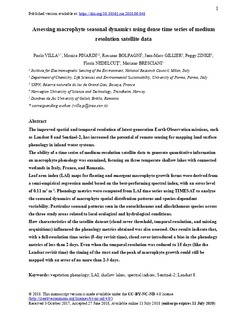| dc.contributor.author | Villa, Paolo | |
| dc.contributor.author | Pinardi, Monica | |
| dc.contributor.author | Bolpagni, Rossano | |
| dc.contributor.author | Gillier, Jean-Marc | |
| dc.contributor.author | Zinke, Peggy | |
| dc.contributor.author | Nedelcut, Florin | |
| dc.contributor.author | Bresciani, Mariano | |
| dc.date.accessioned | 2019-04-10T13:59:00Z | |
| dc.date.available | 2019-04-10T13:59:00Z | |
| dc.date.created | 2018-08-06T10:21:49Z | |
| dc.date.issued | 2018 | |
| dc.identifier.citation | Remote Sensing of Environment. 2018, 216 230-244. | nb_NO |
| dc.identifier.issn | 0034-4257 | |
| dc.identifier.uri | http://hdl.handle.net/11250/2594091 | |
| dc.description.abstract | The improved spatial and temporal resolution of latest-generation Earth Observation missions, such as Landsat 8 and Sentinel-2, has increased the potential of remote sensing for mapping land surface phenology in inland water systems.
The ability of a time series of medium-resolution satellite data to generate quantitative information on macrophyte phenology was examined, focusing on three temperate shallow lakes with connected wetlands in Italy, France, and Romania.
Leaf area index (LAI) maps for floating and emergent macrophyte growth forms were derived from a semi-empirical regression model based on the best-performing spectral index, with an error level of 0.11 m2 m−2. Phenology metrics were computed from LAI time series using TIMESAT to analyze the seasonal dynamics of macrophyte spatial distribution patterns and species-dependent variability. Particular seasonal patterns seen in the autochthonous and allochthonous species across the three study areas related to local ecological and hydrological conditions.
How characteristics of the satellite dataset (cloud cover threshold, temporal resolution, and missing acquisitions) influenced the phenology metrics obtained was also assessed. Our results indicate that, with a full-resolution time series (5-day revisit time), cloud cover introduced a bias in the phenology metrics of less than 2 days. Even when the temporal resolution was reduced to 15 days (like the Landsat revisit time) the timing of the start and the peak of macrophyte growth could still be mapped with an error of no more than 2–3 days. | nb_NO |
| dc.language.iso | eng | nb_NO |
| dc.publisher | Elsevier | nb_NO |
| dc.rights | Attribution-NonCommercial-NoDerivatives 4.0 Internasjonal | * |
| dc.rights.uri | http://creativecommons.org/licenses/by-nc-nd/4.0/deed.no | * |
| dc.title | Assessing macrophyte seasonal dynamics using dense time series of medium resolution satellite data | nb_NO |
| dc.type | Journal article | nb_NO |
| dc.type | Peer reviewed | nb_NO |
| dc.description.version | acceptedVersion | nb_NO |
| dc.source.pagenumber | 230-244 | nb_NO |
| dc.source.volume | 216 | nb_NO |
| dc.source.journal | Remote Sensing of Environment | nb_NO |
| dc.identifier.doi | 10.1016/j.rse.2018.06.048 | |
| dc.identifier.cristin | 1599840 | |
| dc.description.localcode | © 2018. This is the authors’ accepted and refereed manuscript to the article. Locked until 11.7.2020 due to copyright restrictions. This manuscript version is made available under the CC-BY-NC-ND 4.0 license http://creativecommons.org/licenses/by-nc-nd/4.0/ | nb_NO |
| cristin.unitcode | 194,64,91,0 | |
| cristin.unitname | Institutt for bygg- og miljøteknikk | |
| cristin.ispublished | true | |
| cristin.fulltext | original | |
| cristin.qualitycode | 2 | |

